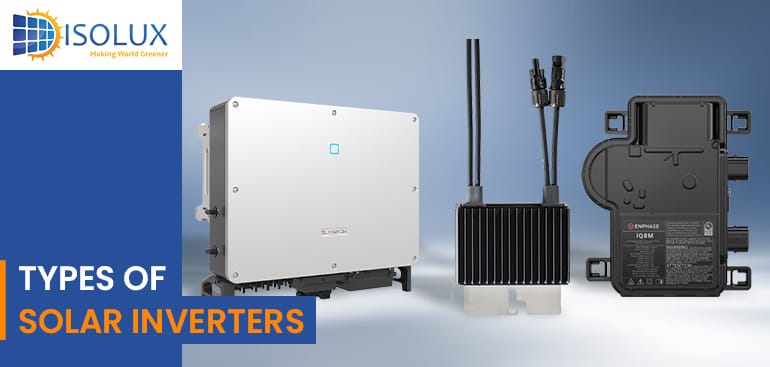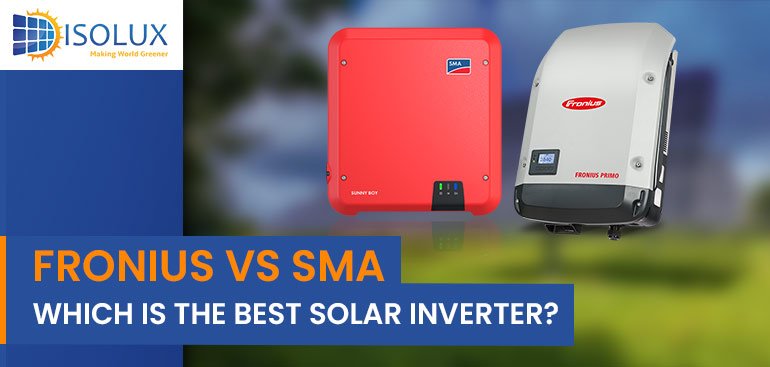Solar inverters are essential components in photovoltaic (PV) systems, converting the direct current (DC) generated by solar panels into alternating current (AC) suitable for household appliances and grid integration. Understanding the different types of solar inverters is crucial for optimizing system performance and ensuring compatibility with specific installation conditions.
What is an Inverter?
An inverter is a crucial component of a solar energy system that converts the direct current (DC) electricity generated by solar panels into alternating current (AC) electricity, which is used to power homes and businesses. Without an inverter, the electricity produced by solar panels would not be compatible with household appliances or the electrical grid.
5 Types of Solar Inverters
1. String Inverters
String inverters are the most commonly used in residential and commercial solar installations. In this configuration, multiple solar panels are connected in series to form a “string,” and the combined DC output is fed into a single inverter. While cost-effective and reliable, string inverters can experience reduced efficiency if one panel in the string is shaded or underperforming, as it affects the entire system’s output.
2. Microinverters
Microinverters are small devices installed on each individual solar panel, converting DC to AC at the panel level. This setup allows each panel to operate independently, so shading or issues with one panel don’t impact the performance of others. Microinverters offer enhanced system efficiency and monitoring but come at a higher cost compared to string inverters.
3. Hybrid Inverters
Hybrid inverters, also known as multi-mode inverters, can simultaneously manage inputs from solar panels and battery storage systems. They allow for the storage of excess energy produced during the day for use at night or during power outages. Hybrid inverters are ideal for those looking to incorporate battery storage into their solar setup, either immediately or in the future.
4. Battery Inverters
Battery inverters are designed specifically to convert stored DC energy from batteries into AC power for household use. They are typically used in off-grid systems or in setups where battery storage is added to an existing solar installation without replacing the current inverter.
5. Power Optimisers
Power optimisers function similarly to microinverters as they are connected to individual solar panels. However, unlike microinverters, they are not standalone inverters and must be used alongside a string inverter to convert DC energy into usable AC power. Power optimisers enhance system performance by improving energy efficiency and mitigating the impact of shading or panel mismatches. They offer a cost-effective upgrade over traditional string inverter systems, delivering better energy output at a lower price compared to microinverters.
What Does a Solar Inverter Look Like?
Solar inverters come in various shapes and sizes, but they generally have a robust, rectangular design with a display screen and several input/output ports. They are built to withstand outdoor conditions, with weather-resistant enclosures to protect internal components. The appearance can vary depending on the type and manufacturer, but functionality remains consistent across models.
What Type of Inverter Should I Choose?
Selecting the right inverter involves considering several factors:
- System Compatibility: Ensure the inverter matches your solar system’s voltage and current specifications.
- Efficiency: Look for inverters with high conversion efficiency to maximize energy production.
- Warranty and Support: Opt for inverters that come with substantial warranty periods and reliable customer support.
- Budget: Balance the initial investment with long-term benefits, considering both upfront costs and potential energy savings.
- Installation Environment: Consider environmental factors such as temperature fluctuations and exposure to elements, ensuring the chosen inverter is suitable for local conditions.
Solar Inverter Brands Available in Australia
Several reputable solar inverter brands are available in Australia, including:
Fronius – Known for high-quality and reliable string inverters.
SMA – Offers efficient and durable solar inverters.
SolarEdge – Specializes in optimizers and high-performance inverters.
Enphase – Popular for microinverters that enhance system efficiency.
Huawei – Provides advanced hybrid and battery inverters.
GoodWe – A cost-effective option with reliable performance.
Growatt – Offers affordable yet efficient solar inverters.
How to Choose a Good Inverter
Selecting the right inverter involves considering several factors:
- System Compatibility: Ensure the inverter matches your solar system’s voltage and current specifications.
- Efficiency: Look for inverters with high conversion efficiency to maximize energy production.
- Warranty and Support: Opt for inverters that come with substantial warranty periods and reliable customer support.
- Budget: Balance the initial investment with long-term benefits, considering both upfront costs and potential energy savings.
- Installation Environment: Consider environmental factors such as temperature fluctuations and exposure to elements, ensuring the chosen inverter is suitable for local conditions.
Conclusion
For residents in Sydney, Perth, and Brisbane, consulting with local solar installers like Isolux Solar can provide personalized recommendations tailored to specific energy needs and regional considerations. Understanding the various types of solar inverters and their applications is essential for designing an efficient and reliable solar energy system. By evaluating system requirements and environmental factors, you can select an inverter that optimizes performance and aligns with your energy goals.
Also read:



